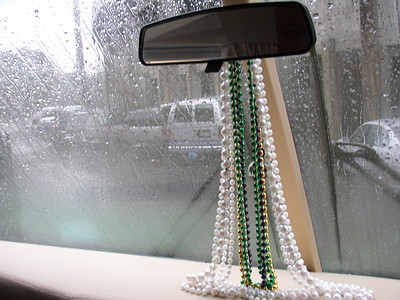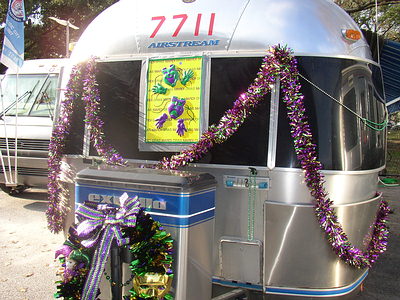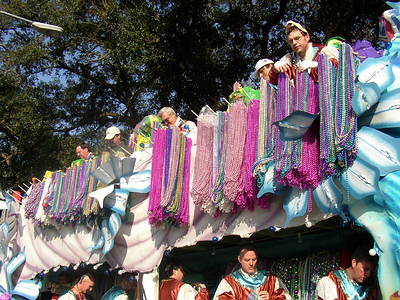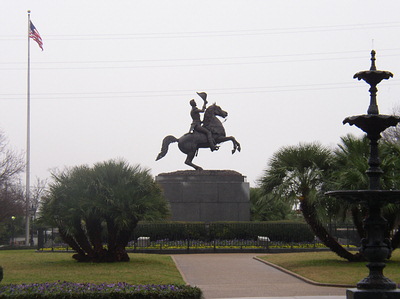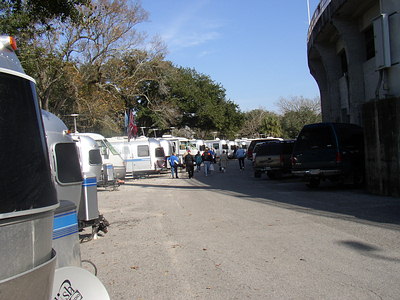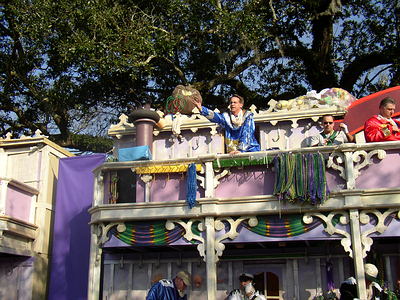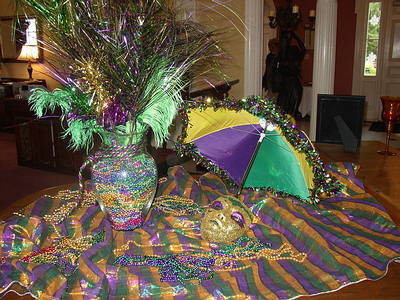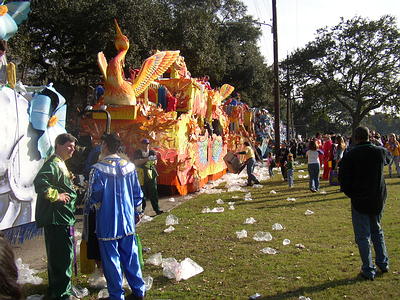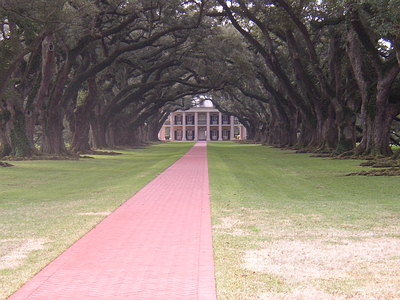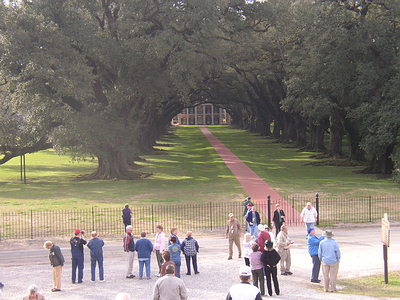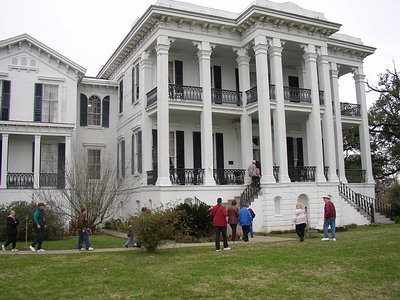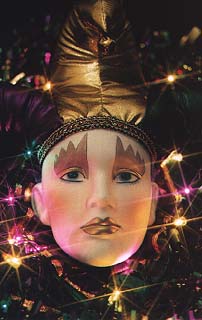Ash Wednesday on the Catholic calendar is 40 days prior to Good Friday. In most parts of the world, the day preceding Ash Wednesday is simply Tuesday. But, in New Orleans it's Mardi Gras, French for Fat Tuesday, the last day for partying and celebration before the sacrifices dictated by the Church for the period of Lent.
The French brought Mardi Gras to New Orleans in 1699. It's also the last day of Carnival, that period of revelry which begins on the day of Epiphany, twelve days after Christmas - or January 6th - and ends on Ash Wednesday, the first day of Lent.
Mardi Gras in New Orleans has become a period of parades, king cakes, colorful beads, party masks, costumes - most of which complies with the official colors of Mardi Gras, green, purple, and gold.
Our departure from our home in the mountains of North Georgia was delayed a day because of a winter ice storm that had roads in Atlanta coated with a quarter to a half inch of ice. Watching vehicles slide into each other on TV convinced us that driving would be perilous. On Sunday the temperature warmed to above freezing, and we took off. From just north of Marietta on I-575 to just beyond Peachtree City on I-85, piles of ice lined the interstate highway, though the pavement was clear. We made it to Shorter, Alabama the first day, then to New Orleans by Monday evening.
Airstreamers have been rallying in New Orleans during Mardi Gras for the last forty-three years. This year about 60 trailers and motorhomes gathered at the City Park Stadium for the rally's start on Tuesday, February 1, 2005. As we arrived on Monday evening we were given a goody bag and several strands of Mardi Gras beads. It rained all during the night, and was chilly and still raining as we met under the stadium grandstand on Tuesday afternoon for the opening meeting. Calvin Skinner and his committee from the Gulf States Unit of WBCCI told us all about the activities to come. We discovered that many of the folks there were those we had traveled with on caravans through the years.
Following the first meeting, we were served "king cake," a delicious apple cake decorated in purple, green, and gold. A small plastic baby doll is always added to the bread dough as the king cake is being made. The person finding the doll acknowledges the find and makes a contribution to the costs of the next cake. That's a king cake.
On Wednesday morning after another rainy night three school buses were at the stadium at 9:00am to take us to the French Quarter where we spent two hours on a walking tour around Jackson Square. At 11:30am we gathered at the Court of Two Sisters for lunch. And what a feast that was with a buffet with 80 some items of food - all excellent. After lunch we had another two hours to wander around town on our own before the buses came back to take us home. The streets were fairly quiet. Guess the bad weather kept a lot of folks home. In the evening the buses were back, this time to take us to Metairie for the first of several Mardi Gras parades. What a deal that was!!
The buses let us off in the parking lot of a shopping mall three or four blocks from where we were to watch the parade. After a brisk walk in the cool night air, we gathered in the medium strip on a divided highway. This spot was picked because it afforded a place to view the parade in two directions. The floats went down one side, then came back on the other. High school bands march and played. There were riders on horseback, sheriff cars and motorcycles. A couple of stretch limosines came by - one, a Humvee that must have been 35 feet long. Then the floats, loaded with costumed people throwing beads into the crowd. At times the air was filled with strings of beads. We were like a bunch of kids grabbing these things out of the air. Occasionally, other things were thrown - frisbees, plastic tooth brushes, outsized glasses, "silver" and "gold" doubloons, candy - but mostly it was those strings of colorful beads. We filled a shopping bag with what must be a half bushel of beads. We had heard that these "throws" were a traditional part of Mardi Gras, but had no idea of the volume. There must have been literally millions of these beads thrown, and this was just one of the 80 Mardi Gras parades in the area. The parade was follwed by an army of street sweepers, and within ten minutes the street was clear of all debris.
Thursday was a day mostly free to do as we pleased. The skies were still cool and overcast, but the rains had stopped. We ventured out in the morning to see if we could find Metairie again. A shopping mall where the buses parked the night before had caught Ann's attention. We found it, had lunch there, and spent an hour or so walking the halls. During the afternoon folks gathered in groups under the stands for a GAM (get acquainted meeting). A lot of introductions and bragging about grandchildren.
That evening the buses came again to take the rally group to the Jefferson Ball Room in the Landmark Hotel in Metairie for an evening of dining and dancing. Lots of the folks wore Mardi Gras costumes and some of the beads acquired at the parade.
Friday morning, after an hour-long trip across the long bridge over Lake Ponchartrain, we stopped at a place out in the boonies, called Fancy Faces. This cottage industry started with a ceramics hobby 25 years ago, and has developed into a million dollar per year business for the families of two brothers. They make beautiful ceramic Mardi Gras masks and other party favors that are sold on the Internet - partyfavors.com. Our tour of the place started with a description of how the plaster of paris molds are made. Then there was a demonstration of how the clay is poured into the mold, left for a precise period of time, and then poured out, leaving a thin (maybe an eighth of an inch) layer which when cooled is lifted out of the mold with the perfect impression of a face. After trimming and cleaning the faces are painted, then fired twice in electric kilns. The result is a beautiful ceramic mask that sells for $10.00 or more, depending on the size. Several of our people decorated a mask to keep, and nearly everyone bought one or more to take home. It was an amazing example of the variety of things people can do to earn a living.
As we exited the building at Fancy Faces, we were surprised to see the sun and blue sky again. It was the first appearance of the sun since leaving home nearly a week earlier. Our next stop was at the Benedict Plantation for a bountiful lunch and tour of the plantation home. Then, it was back across the lake and home for the afternoon. The bridge over Lake Ponchartrain is the longest bridge completely over water in the country - some 24 miles. It connects New Orleans with Mandeville, Louisiana. From the center of the bridge, no land can be seen in any direction. We arrived back home about 2:00pm and had the afternoon to relax before another parade.
On Friday evening the buses came again for another trip to Metairie for two more parades. These parades are put on by social clubs called Krewes. They try to outdo each other with their floats and throws. The Krewes all have names like Alla, Thor, Protius, Hermes, Aquila, Rex, Jason, etc., and the parades carry the names of the Krewes. The three parades we had seen at this point were the Thor, the Aquila, and the Jason.
On Saturday morning we toured the plant where most of the parade floats are assembled - Blaine Kern's Mardi Gras World - across the Mississippi in Algiers, Louisiana. It was an impressive display of float components, though none were under construction as we were there. Cost of the floats varies from $30,000 to over a million - the Endymion floats being the most expensive. In addition to float building, the business included a theater, a party room, a cooking school, and a gift shop. After another serving of king cake, we reboarded the buses for the trip back to New Orleans and lunch.
Lunch on Saturday was at the Praline Connection. No one seemed to know why the name. It was a dance hall, saloon, with a large dining room in an old section of town in downtown New Orleans. They had a buffet set up with red beans and rice, fried chicken, salad, and bread pudding dessert. It was good, but no pralines. After lunch the buses took us to the D-Day Museum, a sobering World War II exhibit primarily focused on the action on Omaha Beach during the invasion of Normandy which ultimately led to the defeat of Nazi Germany.
Later that day we saw the Endymion parade and those huge floats that had built by Kern. The largest was a "train" of five connected floats, all loaded with some Krewe members ready to shower the crowd with strands of beads, stuffed animals, toy footballs, and the like - the "throws." The Endymion parade assembled and started right outside the gates of the stadium where we were parked, so for this one we just walked over.
On Sunday we toured two plantations - Nottoway and Laura. Both were about halfway between New Orleans and Baton Rouge - Nottoway at White Castle; Laura at Vacharie. Nottoway is billed as "The Largest Plantation Home in the South." Built in 1859 by a man named John Hampden Randolph, the mansion boasts 53,000 square feet. The plantation once included some 7,000 acres on a bend of the Mississippi River. Randolph and his wife had eleven children and 176 adult slaves. Now a bed and breakfast facility owned by an Australian businessman, many of the furnishings are original to the Randolph family. After a guided tour of the house, we gathered in the dining room - a separate, more modern building - for a lunch of shrimp and rice. After lunch we went to the Laura Plantation, a Creole plantation in poor condition. The house is being restored, but there is much to be done. Our tour was conducted by a French lady who was difficult to understand with her heavy French accent, but she told many stories of the family that lived there from 1805 until the 1960s. There are 12 buildings at Laura now on the National Register of Historic Places, but all were in a sad state of disrepair. The plantation is named for Laura Locoul Gore, the last of the Locouls to live there. It is her memoirs that have provided the story of the plantation and described the unique Creole culture of those early years. It was at the Laura Plantation that the folk tales of Br'er Rabbit were recorded. These were word-of-mouth tales brought by the Negroes from their homes in West Africa.
Because of the Super Bowl, the Napoleon parade we had been scheduled for Sunday evening was canceled. After the four parades we had seen already, no one was too disappointed.
Monday was the day to go out on the river boat Creole Queen for a tour of the New Orleans harbor and lunch. We'd done that once before, so opted to skip it. Too much partying. Same for the mass chaos parade in the French Quarter on Tuesday.
